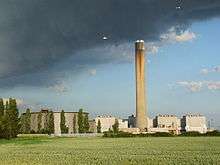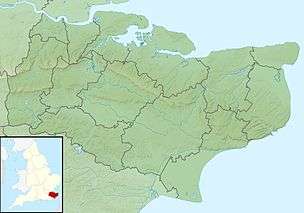Grain Power Station
| Grain Power Station | |
|---|---|
 | |
 Location of Grain Power Station in Kent | |
| Country | England |
| Location |
Isle of Grain Kent |
| Coordinates | 51°26′43″N 0°42′54″E / 51.445181°N 0.715028°ECoordinates: 51°26′43″N 0°42′54″E / 51.445181°N 0.715028°E |
| Commission date | 1979 |
| Decommission date | 2012 |
| Operator(s) | Uniper |
| Thermal power station | |
| Primary fuel | Oil-fired |
| Tertiary fuel | Natural gas |
| Cogeneration? | Yes |
| Combined cycle? | Yes |
| Power generation | |
| Units operational | 5 (2 oil, 3 gas) |
| Make and model | Alstom (CCGT) |
| Nameplate capacity | 1,320 MW (1,770,000 hp) (oil) and 1,275 MW (1,710,000 hp) (gas) |
|
Website Grain Power Station | |
| grid reference TQ886753 | |
Grain Power Station is a CCGT power station and former oil-fired power station in Kent, England, with operational capacity of 1,275 megawatts (1,710,000 hp) owned by Uniper (formerly E.ON UK).
Grain History
Grain was built on a 250-acre (100 ha) site for the nationalised Central Electricity Generating Board. It was built by several contractors including John Laing Construction (Civils), the Cleveland Bridge Company (Steel Frame & Cladding), N. G. Bailey (Electrical), Babcock & Wilcox (Boilers) and GEC Turbine Generators Ltd (steam turbines) beginning before 1975.[1] It opened in 1979. It was located on the Isle of Grain, where the River Medway flows into the Thames Estuary. The station had the second tallest chimney in the UK,[2] at 244 metres (801 ft), visible from a wide area of North Kent and parts of South Essex; Drax Power Station has the tallest chimney, at 259 metres or 850 feet. This chimney was demolished at 11am, on September 7th, 2016. Grain adjoins the site of the BP Kent oil refinery, which closed in 1982. The station burned oil to drive, via steam turbines, two 690 megawatts (930,000 hp) (gross power output – but 30 megawatts (40,000 hp) was used on-site, leaving 660 megawatts (890,000 hp) for export to the Grid) alternators. The station was capable of generating enough electricity to supply approximately 2% of Britain's peak electricity needs.
The station was originally designed to have a total capacity of 3,300 megawatts (4,400,000 hp) from five sets of boiler/turbine combinations. The two remaining oil-fired generating units were mothballed by Powergen in 2002 and 2003, but almost immediately the company began to consider reopening the plant as electricity prices increased rapidly. It was operated by E.ON UK who also operated the nearby Kingsnorth coal-fired station, now also decommissioned.
The plant did not meet the emissions requirements of the Large Combustion Plant Directive and was required to close by 2015.[3]
However, due to the rising costs of maintaining the plant, E.ON UK, the owners of Grain Oil power station, announced that Grain was to be mothballed and the site closed by 31 December 2012.[4] Grain Oil power station generated no further electricity but was maintained as standby capacity for the grid.
In April 2014 the dismantling process at the site began, being carried out by Brown and Mason Ltd; it was expected to take around 2 years to complete. On 10 May 2015, three buildings on the site were destroyed. Three of the five boiler houses were demolished by explosives on Sunday 2 August 2015. The 244m-high chimney was demolished on 7 September 2016.[5] The chimney is now officially the largest structure to ever be demolished in the United Kingdom beating the New Brighton Tower which won the title almost one hundred years ago. [6]
Grain CHP gas plant
A new 1,275MW plant consisting of three natural gas-fired units capable of generating enough electricity to supply around one million homes has been constructed on the site at a cost of £500m. The power station is able to transfer up to 340MW of heat energy recovered from the steam condensation to run the vaporisers in the nearby Liquefied natural gas Terminal, allowing for a reduction in carbon emissions of up to 350,000 tonnes a year.[7]
Construction work on the plant finished in May 2010 at a cost of £580 million, being built by Alstom. Work had started in May 2007. One of the gas turbines was first fired on 2 June 2010. The overall efficiency is expected to be 72%. It has three GT26 gas turbines. It supplies enough electricity for around one million homes, but also 340MW of thermal energy to the nearby natural gas Grain LNG terminal owned by National Grid. The whole scheme is designed to three Alstom KA26 Single-Shaft Combined Cycle Power Plant Power Blocks; these include a STF30C reheat steam turbine, a heat recovery steam generator and a TOPGAS hydrogen-cooled turbogenerator each.[8]
References
- ↑ "A – Z list of Bridges Built by Cleveland Bridge Company". Newcastle University. Retrieved 18 April 2011.
- ↑ Flue gas stack illustration
- ↑ "Large combustion plant directive". E.ON UK.
- ↑ "E.ON UK announces oil-fired Grain-A power station to be mothballed and the site closed by 31 December 2012". E.ON UK.
- ↑ "chimney_at_grain_power_station_to_become_tallest_concrete_structure_ever_demolished". Kent Online. 30 August 2016. Retrieved 5 September 2016.
- ↑ http://www.msn.com/en-gb/news/uknews/landmark-kent-power-station-chimney-blown-up-in-demolition-of-uks-tallest-concrete-structure/ar-AAiAOKJ?ocid=spartanntp
- ↑ "Grain CHP". E.ON UK.
- ↑ TOPGAS
External links
| Wikimedia Commons has media related to Grain Power Station. |
- E.ON
- CHP plant
- 2002 Mothballing plan
- 2003 Reopening
- Gas-fired station
- Gas power station proposal in December 2005
- Go-ahead for gas power station in November 2006
- Demolition begins at Grain Power Station in May 2015
- The whole construction from start to finish, showing the three distinct KA26 CCGT units at E.ON's Talking Energy
